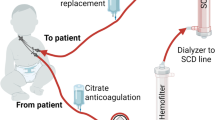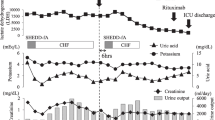Abstract
Tumor lysis syndrome (TLS) is a potentially fatal metabolic complication of chemotherapy for Burkitt lymphoma. It has not been established whether chemotherapy should be delayed in patients with spontaneous TLS, and several studies have shown poor prognoses in this group. This retrospective study evaluated the efficacy and safety of continuous venovenous hemofiltration (CVVH) with prephase chemotherapy using the modified LMB-89 regimen in patients with Burkitt lymphoma and leukemia (BL/L) at a high risk of developing TLS from February 1998 to February 2007. The chemotherapy regimen was followed by the modified LMB-89 protocol. CVVH was applied to all patients before prephase chemotherapy or within 2 h of chemotherapy. The median follow-up was 19.7 months (range 1–97.8). Eight patients had Burkitt lymphoma and three had Burkitt leukemia; their median age was 48 years. The international prognostic indices were >3 for all patients. Seven patients had spontaneous TLS and four patients were at a high risk of TLS. CVVH was continued for 109 h (range 70.5–157.5). No patient had fatal metabolic complications related to TLS. Renal function had recovered fully before induction chemotherapy in all but one patient. The 1-year event-free survival and overall survival rates were both 82%. In conclusion, chemotherapy combined with CVVH might be effective and safe in patients with advanced Burkitt lymphoma and leukemia at a high risk of developing TLS.
Similar content being viewed by others
References
The International Non-Hodgkin’s Lymphoma Prognostic Factors Project (1993) A predictive model for aggressive non-Hodgkin’s lymphoma. N Engl J Med 329:987–994 doi:10.1056/NEJM199309303291402
Blum KA, Lozanski G, Byrd JC (2004) Adult Burkitt leukemia and lymphoma. Blood 104:3009–3020 doi:10.1182/blood-2004-02-0405
Kasamon YL, Swinnen LJ (2004) Treatment advances in adult Burkitt lymphoma and leukemia. Curr Opin Oncol 16:429–435 doi:10.1097/00001622-200409000-00003
Hande KR, Garrow GC (1993) Acute tumor lysis syndrome in patients with high-grade non-Hodgkin’s lymphoma. Am J Med 94:133–139 doi:10.1016/0002-9343(93)90174-N
Hsu HH, Chan YL, Huang CC (2004) Acute spontaneous tumor lysis presenting with hyperuricemic acute renal failure: clinical features and therapeutic approach. J Nephrol 17:50–56
Gasparini M, Rottoli L, Massimino M, Gianni MC, Ballerini E, Ravagnani F et al (1993) Curability of advanced Burkitt’s lymphoma in children by intensive short-term chemotherapy. Eur J Cancer 29A:692–698 doi:10.1016/S0959-8049(05)80348-X
Soussain C, Patte C, Ostronoff M, Delmer A, Rigal-Huguet F, Cambier N et al (1995) Small noncleaved cell lymphoma and leukemia in adults. A retrospective study of 65 adults treated with the LMB pediatric protocols. Blood 85:664–674
Hoelzer D, Ludwig WD, Thiel E, Gassmann W, Löffler H, Fonatsch C et al (1996) Improved outcome in adult B-cell acute lymphoblastic leukemia. Blood 87:495–508
Saccente SL, Kohaut EC, Berkow RL (1995) Prevention of tumor lysis syndrome using continuous veno-venous hemofiltration. Pediatr Nephrol 9:569–573 doi:10.1007/BF00860936
Murphy SB (1980) Classification, staging and end results of treatment of childhood non-Hodgkin’s lymphomas: dissimilarities from lymphomas in adults. Semin Oncol 7:332–339
Cairo MS, Bishop M (2004) Tumour lysis syndrome: new therapeutic strategies and classification. Br J Haematol 127:3–11 doi:10.1111/j.1365-2141.2004.05094.x
Patte C, Auperin A, Michon J, Behrendt H, Leverger G, Frappaz D, Lutz P, Coze C, Perel Y, Raphaël M, Terrier-Lacombe MJ, Société Française d’Oncologie Pédiatrique (2001) The Societe Francaise d’Oncologie Pediatrique LMB89 protocol: highly effective multiagent chemotherapy tailored to the tumor burden and initial response in 561 unselected children with B-cell lymphomas and L3 leukemia. Blood 97:3370–3379 doi:10.1182/blood.V97.11.3370
Rizzieri DA, Johnson JL, Niedzwiecki D, Lee EJ, Vardiman JW, Powell BL et al (2004) Intensive chemotherapy with and without cranial radiation for Burkitt leukemia and lymphoma: final results of Cancer and Leukemia Group B Study 9251. Cancer 100:1438–1448 doi:10.1002/cncr.20143
Lacasce A, Howard O, Lib S, Fisher D, Weng A, Neuberg D et al (2004) Modified magrath regimens for adults with Burkitt and Burkitt-like lymphomas: preserved efficacy with decreased toxicity. Leuk Lymphoma 45:761–767 doi:10.1080/1042819031000141301
Mead GM, Sydes MR, Walewski J, Grigg A, Hatton CS, Pescosta N, Guarnaccia C, Lewis MS, McKendrick J, Stenning SP, Wright D, UKLG LY06 collaborators (2002) An international evaluation of CODOX-M and CODOX-M alternating with IVAC in adult Burkitt’s lymphoma: results of United Kingdom Lymphoma Group LY06 study. Ann Oncol 13:1264–1274 doi:10.1093/annonc/mdf253
Lee EJ, Petroni GR, Schiffer CA, Freter CE, Johnson JL, Barcos M et al (2001) Brief-duration high-intensity chemotherapy for patients with small noncleaved-cell lymphoma or FAB L3 acute lymphocytic leukemia: results of Cancer and Leukemia Group B Study 9251. J Clin Oncol 19:4014–4022
Thomas DA, Cortes J, O’Brien S, Pierce S, Faderl S, Albitar M et al (1999) Hyper-CVAD program in Burkitt’s-type adult acute lymphoblastic leukemia. J Clin Oncol 17:2461–2470
Diviné M, Casassus P, Koscielny S, Bosq J, Sebban C, Le Maignan C, Stamattoulas A, Dupriez B, Raphaël M, Pico JL, Ribrag V, GELA, GOELAMS (2005) Burkitt lymphoma in adults: a prospective study of 72 patients treated with an adapted pediatric LMB protocol. Ann Oncol 16:1928–1935 doi:10.1093/annonc/mdi403
Annemans L, Moeremans K, Lamotte M, Garcia Conde J, van den Berg H, Myint H et al (2003) Incidence, medical resource utilisation and costs of hyperuricemia and tumour lysis syndrome in patients with acute leukaemia and non-Hodgkin’s lymphoma in four European countries. Leuk Lymphoma 44:77–83 doi:10.1080/1042819021000054661
Stapleton FB, Strother DR, Roy S III, Wyatt RJ, McKay CP, Murphy SB (1988) Acute renal failure at onset of therapy for advanced stage Burkitt lymphoma and B cell acute lymphoblastic lymphoma. Pediatrics 82:863–869
Tan HK, Bellomo R, M’Pis DA, Ronco C (2001) Phosphatemic control during acute renal failure: intermittent hemodialysis versus continuous hemodiafiltration. Int J Artif Organs 24:186–191
Yim BT, Sims-McCallum RP, Chong PH (2003) Rasburicase for the treatment and prevention of hyperuricemia. Ann Pharmacother 37:1047–1054 doi:10.1345/aph.1C336
Hummel M, Reiter S, Adam K, Hehlmann R, Buchheidt D (2008) Effective treatment and prophylaxis of hyperuricemia and impaired renal function in tumor lysis syndrome with low doses of rasburicase. Eur J Haematol 80:331–336 doi:10.1111/j.1600-0609.2007.01013.x
Sood AR, Burry LD, Cheng DK (2007) Clarifying the role of rasburicase in tumor lysis syndrome. Pharmacotherapy 27:111–121 doi:10.1592/phco.27.1.111
Goldman SC, Holcenberg JS, Finklestein JZ, Hutchinson R, Kreissman S, Johnson FL et al (2001) A randomized comparison between rasburicase and allopurinol in children with lymphoma or leukemia at high risk for tumor lysis. Blood 97:2998–3003 doi:10.1182/blood.V97.10.2998
Jeha S, Kantarjian H, Irwin D, Shen V, Shenoy S, Blaney S et al (2005) Efficacy and safety of rasburicase, a recombinant urate oxidase (Elitek), in the management of malignancy-associated hyperuricemia in pediatric and adult patients: final results of a multicenter compassionate use trial. Leukemia 19:34–38
Trifilio S, Gordon L, Singhal S, Tallman M, Evens A, Rashid K et al (2006) Reduced-dose rasburicase (recombinant xanthine oxidase) in adult cancer patients with hyperuricemia. Bone Marrow Transplant 37:997–1001 doi:10.1038/sj.bmt.1705379
Author information
Authors and Affiliations
Corresponding author
Rights and permissions
About this article
Cite this article
Choi, K.A., Lee, J.E., Kim, YG. et al. Efficacy of continuous venovenous hemofiltration with chemotherapy in patients with Burkitt lymphoma and leukemia at high risk of tumor lysis syndrome. Ann Hematol 88, 639–645 (2009). https://doi.org/10.1007/s00277-008-0642-1
Received:
Accepted:
Published:
Issue Date:
DOI: https://doi.org/10.1007/s00277-008-0642-1




